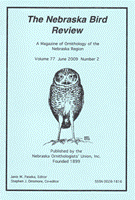Nebraska Ornithologists' Union

Nebraska Bird Review
Date of this Version
2000
Document Type
Article
Abstract
This fall 2000 season was marked by a very westerly flavor to the passerine migration with many sightings of western warblers, vireos, and flycatchers in western Nebraska. Most notably, Townsend's Warblers and Cassin's Vireos were seen in good numbers. Additionally, three sightings of Virginia's Warbler and five of Dusky Flycatcher added to the excitement. In this note, we report this fall's sightings of Virginia's Warbler and comment on the status of this species in Nebraska.
On 26 August 2000, Dinsmore observed a Virginia's Warbler (Vermivora virginiae) along the north side of Oliver Reservoir. He studied the bird at close range from 9:52-10:05 a.m. as it foraged with a large flock of migrant passerines. The identification of the bird as a Virginia's Warbler was straightforward. Features noted included the generally dull gray/brown plumage, slightly paler underparts with a very dull yellowish or buff patch at the center of the breast and bright yellow undertail coverts, conspicuous white eyering. plain, unmarked wings, and the nearly constant sideways flicking of the tail. On the basis of the brown tones to the plumage, dusky underparts, lack of a rufous cap, and only a faint hint of a yellow/buff breast patch, he concluded that the bird was an immature female Virginia's Warbler (see Dunn and Garrett 1997). Fontaine saw this individual briefly on 27 August in the same general area.
On 27 August 2000, Fontaine observed a Virginia's Warbler along the gravel road South of exit 1 off Interstate 80 in southwestern Kimball County. The bird was seen shortly after sunrise from 6:45-6:50 a.m. foraging in a stand of Limber Pine approximately 15 meters from the roadside. The Virginia's Warbler was in the company of a loose flock of migrants composed of Wilson's Warblers, Blue-gray Gnatcatchers, and a Brown Thrasher. The bird was seen flicking its tail as it moved from tree to tree. Based on the clean gray breast and bold lemon yellow undertail coverts, he concluded the bird was an adult female.


Comments
Dinsmore in Nebraska Bird Review (September 2000) 68(3). Copyright 2000, Nebraska Ornithologists' Union. Used by permission.